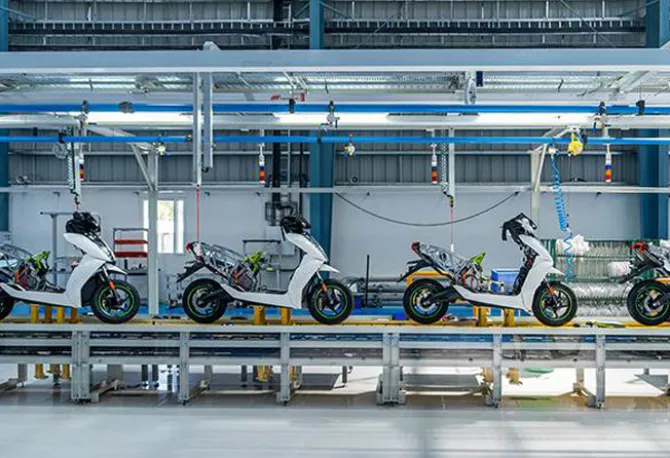-
CENTRES
Progammes & Centres
Location
India can grasp world leadership in EVs, and the opportunity is at hand. It's the right time for policymakers and the industry to embark on this path with resolute and collaborative action.

India’s electric vehicle (EV) transformation is well underway. As annual EV sales crossed the remarkable one-million-unit mark in 2022, the two-wheeler segment has emerged as the brightest spot, currently accounting for around 50 percent of all registered EVs. Strong government support combined with a dynamic manufacturing ecosystem characterised by homegrown innovation and investment have been key drivers of growth in this segment. India's electric two-wheeler industry has effectively catered to domestic demand, but it's crucial to look beyond our borders. There is now a global uptick in demand for affordable electric two-wheelers, particularly in Latin America, South Asia, and Africa. Asia is already the global hotspot for two-wheelers, accounting for over 90 percent of global sales. Africa has over 80 million motorcycle users, many of whom will transition to EVs in the coming years. So far, the largest beneficiary of this growing demand has been Chinese manufacturers, exporting more than 20 million units annually. However, with more than 60 local original equipment manufacturers producing two-wheelers in a variety of specifications and an expected annual production capacity of 30 million by 2026, it would seem that India is ready to challenge China on the global stage. To truly compete with China and attain global leadership, however, India must develop a targeted policy roadmap.
Strong government support combined with a dynamic manufacturing ecosystem characterised by homegrown innovation and investment have been key drivers of growth in this segment.
The need for a policy reset has been further amplified by recent developments related to the disbursement of subsidies under the FAME scheme. The first uncertainty has been created by the reduction of the FAME subsidy for two-wheelers from INR 15,000 to INR 10,000 per kWh of battery capacity which was announced in April 2023 and implemented with only a two months’ notice in June 2023. This has led to major fluctuations in electric two-wheeler sales and raised questions about how this segment will be treated in the upcoming FAME-III scheme expected to be announced next year. Moreover, the investigations being carried out by the Department of Heavy Industries into certain manufacturers for falsely claiming subsidies despite violating the localisation requirements have spooked the industry. Specifically, the prospect of facing penalties amounting to INR 500 crore for reimbursing previously claimed subsidies and the potential withholding of subsidies even for non-disputed portions of the subsidies has left numerous manufacturers potentially staring at insolvency. There is a pressing need for a new strategy that establishes ambitious yet attainable goals, especially for increasing domestic value addition. This roadmap should outline incentive schemes and provide clear, time-bound plans for gradually reducing this support in the coming years. Furthermore, it must aim to eliminate any ambiguity regarding norms related to local content, including certification and compliance procedures. A formalised mechanism for consultations with the private sector would enable policymakers to plan and implement its schemes more effectively. Such a mechanism would also quickly alert policymakers to the need for course corrections or refinements in the roadmap and its various schemes. This would contribute towards rapid, agile, and cutting-edge policies.
A formalised mechanism for consultations with the private sector would enable policymakers to plan and implement its schemes more effectively.
Japan’s world-renowned automotive industry serves as a useful example in this regard. Its annual production grew from modest beginnings in the early 1950s to over 5 million vehicles in 1970, to its peak of 13.5 million in 1993. Their exports grew similarly, from a handful in the early 1950s to 10,000 vehicles in 1961 to over 1 million by 1970. Today, Japanese manufacturers such as Toyota and Honda are global leaders, while Japanese component makers are considered the gold standard the world over. What propelled the remarkable ascent of the Japanese automotive industry? It was the Ministry of International Trade and Industry (MITI), which crafted comprehensive industry-specific long-term plans and demonstrated remarkable adaptability by closely collaborating with the private sector to tackle challenges. Through ongoing consultations, MITI continuously improved various aspects of its industrial policy, including its support for national champions, foreign direct investment regulations, and approval and certification processes. MITI's agility and responsiveness have played a pivotal role in propelling the Japanese automotive industry and India's Ministry of Commerce and Industry must strive towards implementing a similar consultative policymaking process.
Japanese manufacturers such as Toyota and Honda are global leaders, while Japanese component makers are considered the gold standard the world over.
In the immediate future, it is also important that the government focuses on swiftly and fairly resolving the disputes related to the FAME scheme. Moreover, innovation must be encouraged through targeted incentives for R&D efforts both within the FAME and the PLI schemes. Centering innovation as a key pillar of indigenisation efforts will be also essential if the Indian electric two-wheeler industry is to shift from simply 'Making in India’ to ‘Creating in India for the World.’ India can grasp world leadership in EVs, and the opportunity is at hand. The immediate route lies through the electric two-wheeler segment. It's the right time for policymakers and the industry to embark on this path with resolute and collaborative action.
Promit Mookherjee is an Associate Fellow at the Observer Research Foundation.
The views expressed above belong to the author(s). ORF research and analyses now available on Telegram! Click here to access our curated content — blogs, longforms and interviews.

Promit Mookherjee was an Associate Fellow at the Centre for Economy and Growth in Delhi. His primary research interests include sustainable mobility, techno-economics of low ...
Read More +